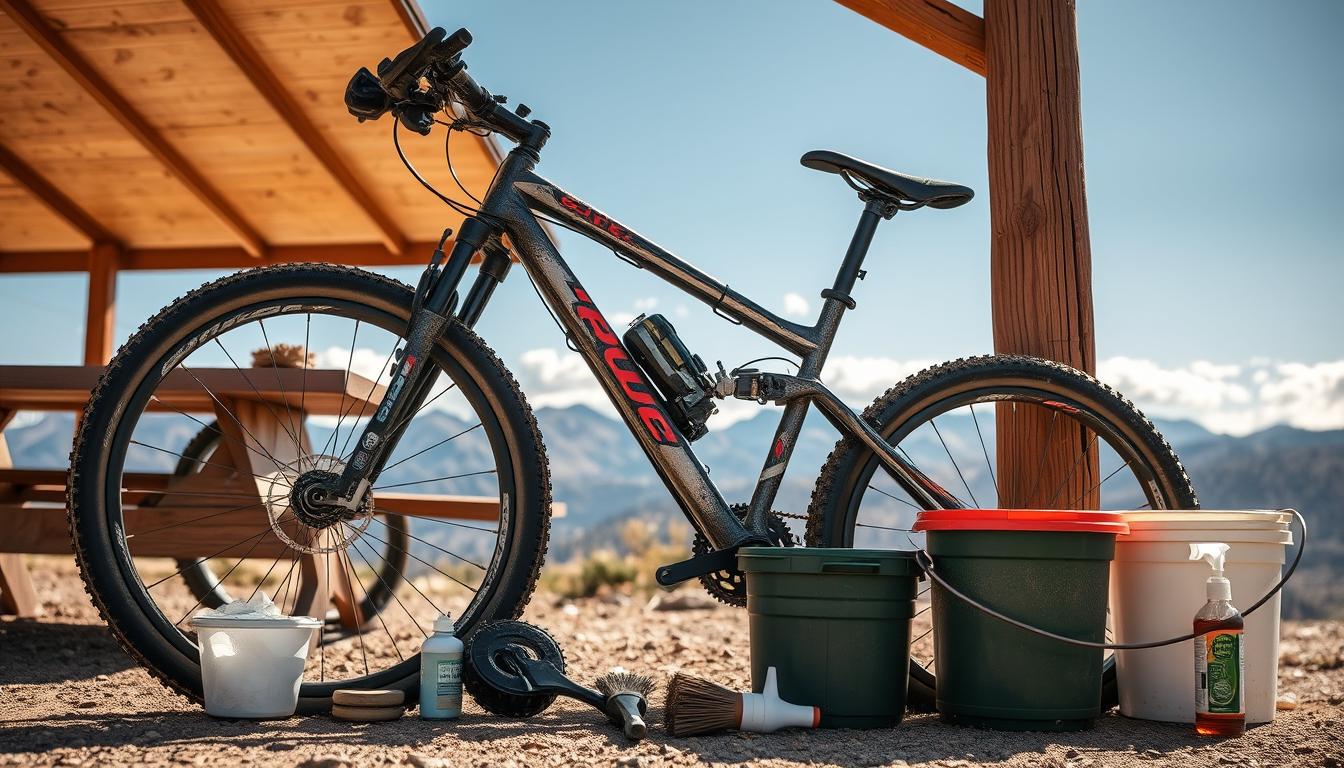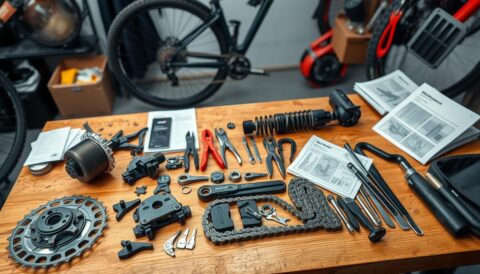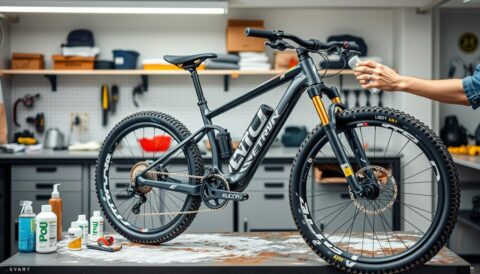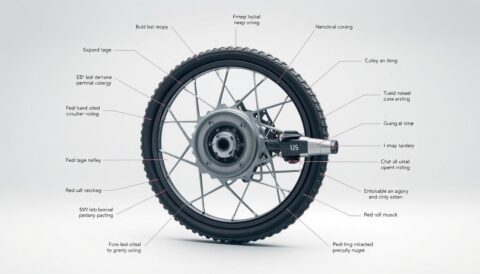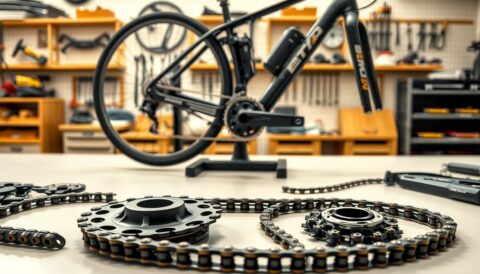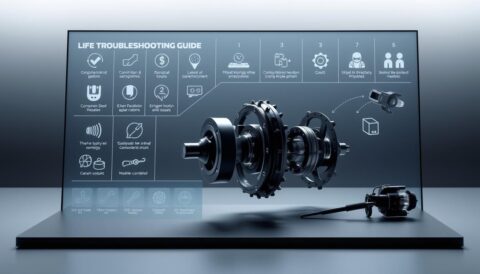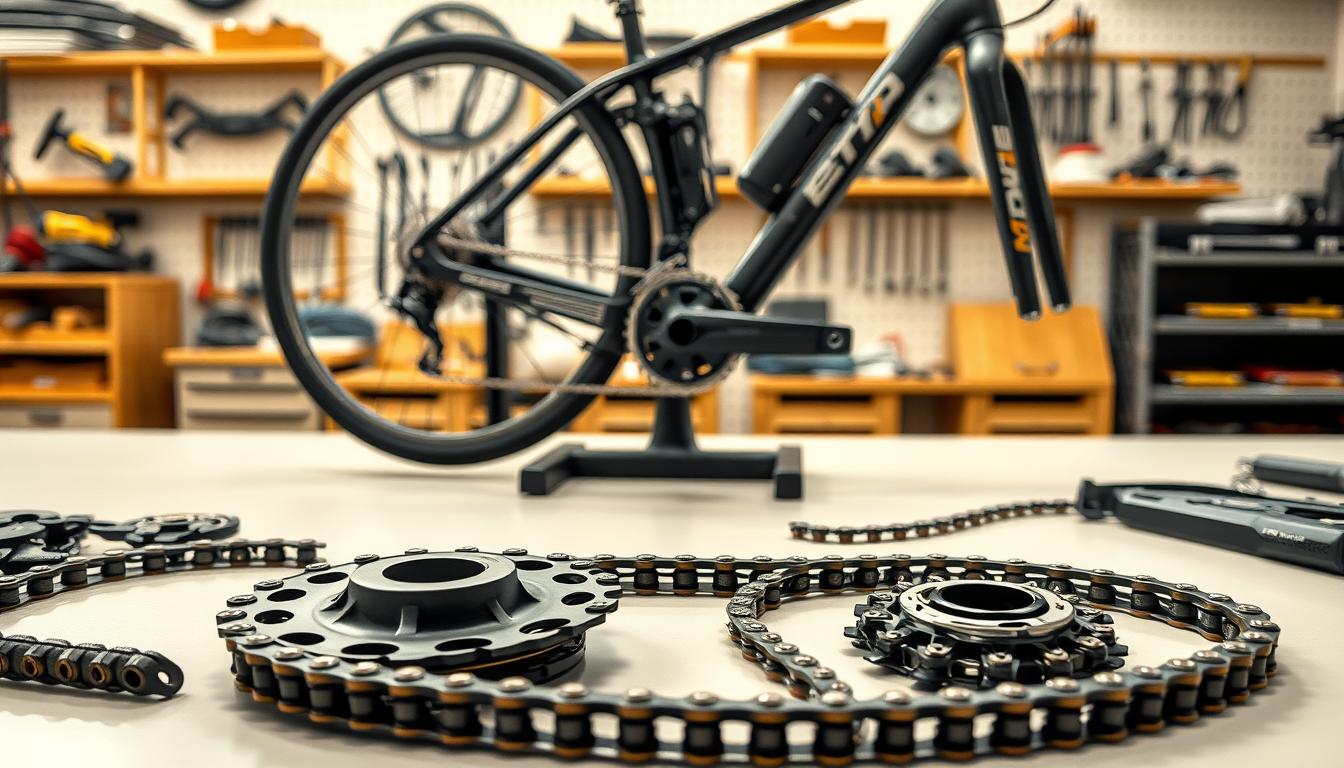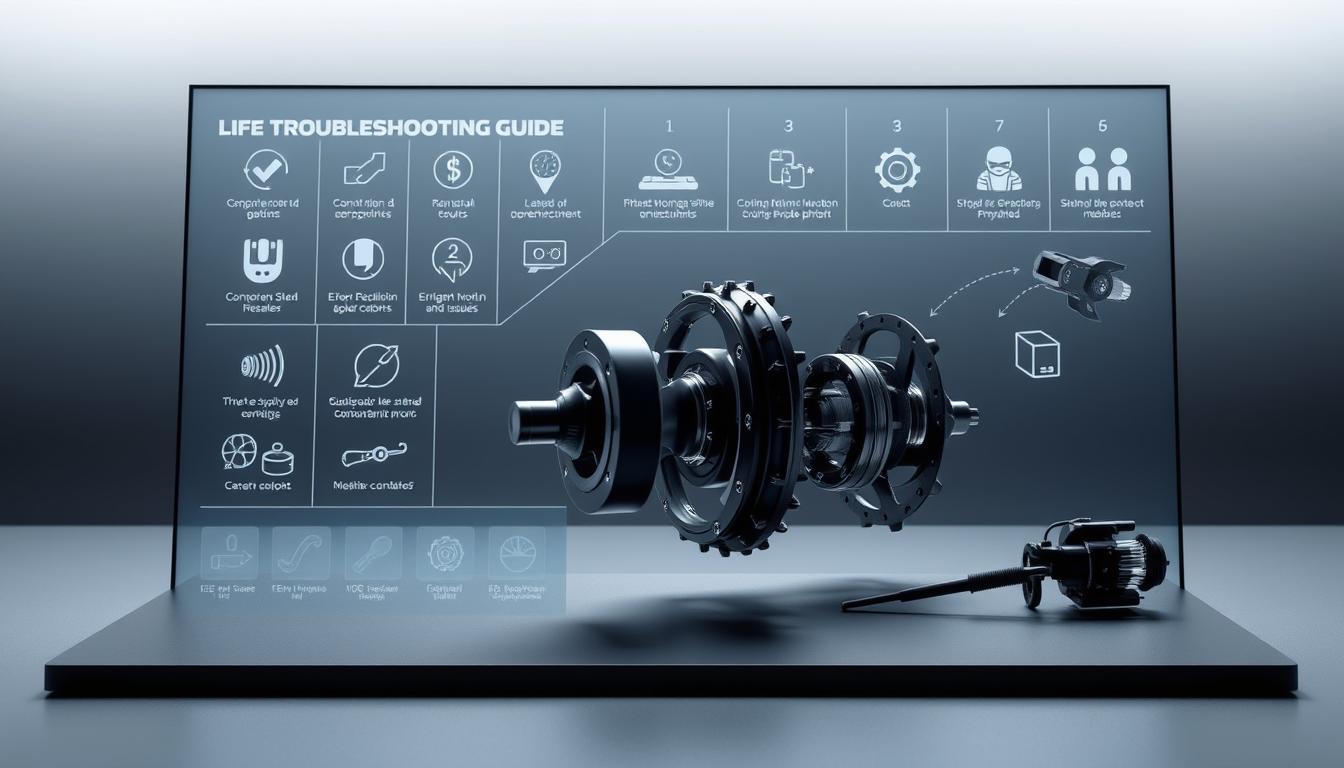Keeping your mountain bike clean is vital for its performance and longevity. Bike washing goes beyond mere looks. It’s a crucial part of MTB care that affects how well your bicycle works.
Dirt and grime can quickly harm your two-wheeled friend. Regular cleaning prevents wear on parts and keeps your bike running smoothly. It also extends the life of important components.
Cleaning after each ride is key, no matter the trail conditions. Debris build-up can cause mechanical problems and reduce shifting accuracy. It may also affect your bike’s overall performance.
Experts agree that a clean bike is a happy bike. Spending a few minutes on maintenance after riding can save you money. It will also ensure a more reliable cycling experience.
Why Regular Bike Cleaning is Essential for Performance
Regular cleaning is vital for your mountain bike’s performance. It protects your investment and keeps your ride in top shape. Proper maintenance safeguards critical components and enhances overall performance.
Dirt and grime can silently destroy your bike’s key parts. This causes unnecessary wear and reduces performance. Regular cleaning helps prevent these issues.
Impact on Bike Components and Longevity
Mountain bikes are precision machines that need consistent care. Neglecting cleaning can lead to serious problems.
- Accelerated component degradation
- Increased friction in moving parts
- Potential mechanical failures
“A clean bike is a happy bike” – Professional MTB Mechanic
Prevention of Wear and Tear
Regular cleaning helps spot potential issues early on. This proactive maintenance can save cyclists a lot of money over time.
- Inspect chain for rust and wear
- Check brake pad condition
- Examine gear shifting mechanisms
Benefits for Riding Experience
Clean bikes perform better. Removing dirt improves gear shifting and reduces noise. This ensures smoother rides and better MTB performance.
Spending just 20-30 minutes after each ride can make a big difference. It extends your mountain bike’s lifespan and improves riding quality.
Essential Cleaning Supplies and Tools
A comprehensive bike cleaning kit is vital for your mountain bike’s upkeep. It ensures top performance and longevity. The right MTB washing supplies are key to keeping your bicycle in prime condition.
Basic Cleaning Equipment
Every cyclist needs core bicycle maintenance tools for effective cleaning. Your essential kit should include several items. These range from microfibre cloths to bike-specific cleaning solutions.
- Multiple clean microfibre cloths
- Soft and firm bristle brushes
- Bucket for water
- Garden hose with adjustable nozzle
- Bike-specific cleaning solution
Pro tip: Avoid high-pressure washers as they can damage delicate bike components.
Specialised Cleaning Products
Targeted MTB washing supplies make cleaning more efficient. Some recommended products include specific solutions and devices. These help tackle different parts of your bike effectively.
- Eco-friendly degreasers for drivetrain cleaning
- Disc brake cleaning solution
- Chain cleaning devices
- Bike polish with moisture dispersant
Optional but Helpful Tools
Certain bicycle maintenance tools can greatly improve your cleaning process. While not essential, they offer added convenience and efficiency. Consider these items to enhance your bike care routine.
- Bike maintenance stand
- Chain lubricant
- Protective spray for frame
- Specialised brush kit
Choose high-quality, bike-specific products for best results. These protect your mountain bike while effectively removing dirt. Your bike will thank you for the extra care and attention.
Mountain Bike Cleaning Tips: Step-by-Step Guide
Proper cleaning keeps your mountain bike in top shape. This guide will show you how to wash your bike effectively. Follow these steps to maintain your ride’s performance and lifespan.
Gather these supplies before you start cleaning. You’ll need bike-specific cleaner, degreaser, and soft brushes. Also, get clean rags, a 15-quart Rubbermaid bucket, and a water source.
- Bike-specific cleaner
- Degreaser
- Soft brushes
- Clean rags
- Bucket (15-quart Rubbermaid recommended)
- Water source
Follow these steps to clean your bike thoroughly:
- Rinse Thoroughly: Use gentle water to remove loose dirt and debris
- Apply Degreaser: Target the drivetrain, allowing it to soak for 5 minutes
- Scrub Methodically: Work from top to bottom, using specific brushes for different components
- Pay Special Attention to Chain: Use a dedicated chain cleaning tool
- Rinse Completely: Ensure all cleaning solution is removed
- Dry Carefully: Use clean cloths or compressed air
Pro Tip: Maintain a 30 cm distance when using a pressure washer to prevent damage to sensitive bike components.
Lubrication is the final step in cleaning your mountain bike. Apply chain lube while back-pedalling for at least six rotations. Let it soak for about 5 minutes.
Regular cleaning prevents wear and keeps your bike running smoothly. Make it a habit to clean your bike after muddy rides.
Proper Drivetrain Maintenance and Cleaning
Keeping your mountain bike’s drivetrain in top shape is vital. Regular care of the chain, cassette, and derailleur improves performance and longevity. Your rides will be smoother, and your bike will last longer.
Chain Cleaning Techniques
Proper chain maintenance is key. Use a chain cleaning device or degreaser to start. Rotate the cranks while cleaning to reach every link.
Choose a bike-friendly degreasing solution. Scrub carefully with a special chain brush for best results.
- Use a dedicated chain cleaning device or degreaser
- Rotate the cranks while cleaning to reach all chain links
- Use a specific bike-friendly degreasing solution
- Scrub carefully with a designated chain brush
Cassette and Derailleur Care
Clean the cassette with a stiff-bristled brush and mild solution. For the derailleur, focus on cleaning pulleys and jockey wheels. Check for smooth movement and signs of wear.
- Cleaning derailleur pulleys and jockey wheels
- Checking for smooth movement
- Inspecting for any signs of wear or damage
Lubrication Best Practices
Proper lubrication finishes your drivetrain maintenance. Choose your lubricant wisely based on riding conditions. Use dry lubricant for dry conditions and wet lubricant for wet rides.
Apply lube sparingly to avoid attracting dirt. Wipe off any excess to prevent buildup.
- Dry conditions: Use dry lubricant
- Wet conditions: Select wet lubricant
- Apply lube sparingly to avoid dirt attraction
- Wipe excess lubricant to prevent buildup
Remember: A clean and well-maintained drivetrain ensures smoother rides and extends the life of your mountain bike components.
Frame and Component Care Techniques
Proper bike maintenance is crucial for optimal performance and longevity. Each part of your mountain bike needs specific cleaning methods. Careful attention to frame cleaning and component care is essential.
Start by choosing the right tools for different parts. Professional technicians suggest using various brushes for specific areas:
- Soft Washing Brush for frame and general surfaces
- Two Prong Brush for narrow spaces
- Claw Brush for comprehensive drivetrain cleaning
- Drivetrain Detailing Brush for precision work
Use a gentle approach for thorough cleaning. Many bike makers recommend Blue Dawn dish soap as a trusted solution. Mechanics often use two separate buckets to prevent cross-contamination.
“Careful cleaning preserves your bike’s performance and extends its lifespan,” says a professional bike technician.
After cleaning, apply protective products like Pedro’s Bike Lust or Muc-Off Bike Protect. These help prevent mud and dust build-up, especially in wet conditions. Be careful with silicon-based polishes in dry areas, as they can attract dust.
Regular maintenance includes checking and regreasing important parts. Focus on saddle rail clamp bolts, seat post, headset, stem bolts, and pedal threads. This helps prevent squeaking or seizing during rides.
Special Considerations for E-Mountain Bikes
E-mountain bikes need unique care strategies beyond regular bicycle maintenance. They require a nuanced approach to protect electronic parts and ensure top performance.
E-bike upkeep safeguards delicate components while maximising efficiency. This careful attention helps maintain your bike’s longevity and reliability.
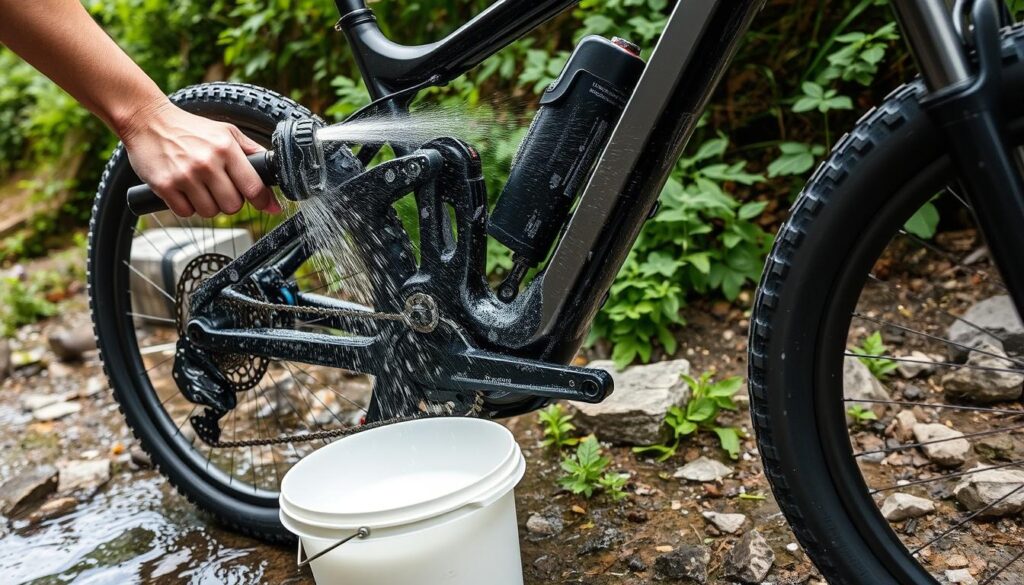
Battery and Electronics Protection
Prioritising battery safety is vital when caring for your electric mountain bike. Follow these key guidelines for the best results.
- Remove the battery before thorough cleaning
- Cover the display unit with protective film
- Avoid direct water streams near electrical connections
Safe Cleaning Methods
E-MTB cleaning calls for gentle techniques to preserve sensitive electronics. Use soft cloths and specialised cleaning products for electric bicycles.
Avoid high-pressure washers as they might damage waterproof seals. Gentle, targeted cleaning approaches will protect your investment effectively.
Protect your investment by using gentle, targeted cleaning approaches.
Post-Cleaning Checks
After cleaning your electric mountain bike, perform these essential checks:
- Inspect electrical connections for moisture
- Ensure battery is completely dry
- Verify battery connection points
- Test electrical systems before riding
Regular maintenance prolongs your e-bike’s life and ensures consistent performance. This care is crucial for tackling challenging terrains with confidence.
Conclusion
Regular bicycle cleaning is vital for your mountain bike’s performance and longevity. It’s a crucial aspect of bike maintenance. A consistent cleaning routine preserves components, prevents wear, and ensures optimal riding experiences.
MTB care benefits go beyond surface-level shine. Meticulous maintenance protects your investment. Each cleaning session helps catch potential issues before they become costly repairs.
Your mountain bike needs attention and care. Thorough cleaning after each ride extends your bike’s lifespan. It maintains peak performance and ensures safer, smoother cycling experiences.
Clean your chain weekly and use appropriate lubricants. Perform a test ride after maintenance to confirm everything works perfectly.
These maintenance practices will transform your riding experience. Professional bike care is an investment in your passion for mountain biking.
FAQ
How often should I clean my mountain bike?
Clean your mountain bike after every hard ride or two. This is especially important after muddy or wet rides. For e-bikes, clean weekly if riding through tough terrains.
Regular cleaning prevents parts from wearing out too quickly. It also keeps your bike working well.
What supplies do I need to clean my mountain bike?
You’ll need clean rags, soft and firm brushes, water, and a hosepipe. Bike-specific cleaner or soap, eco-friendly degreaser, and a chain-cleaning device are also useful.
Don’t forget bike polish, rubbing alcohol for disc brakes, and chain lubricant. A bike stand can be helpful for thorough cleaning.
Can I use a high-pressure washer to clean my bike?
It’s best to avoid high-pressure washing. It can force water into bearings and delicate parts, causing damage. Instead, use a gentle hosepipe and soft brushes for effective cleaning.
How do I clean the bike’s drivetrain?
Apply degreaser to the drivetrain and let it soak. Use special brushes to clean chainrings, derailleur, cassette, and chain. Scrub well, rinse thoroughly, and dry completely.
After cleaning, apply chain lubricant suited to your riding conditions.
Are there special cleaning considerations for electric mountain bikes?
Remove the battery before cleaning and cover the display with cling film. Be extra careful around electrical connections and ensure thorough drying. Check all connections after cleaning.
Most e-bikes are water-resistant, but careful handling is crucial.
What’s the best way to dry my mountain bike after cleaning?
Use a clean, soft cloth or an air compressor to dry your bike. Gently bounce the bike to remove water from hard-to-reach spots.
Make sure all parts are completely dry before lubricating and storing. This is especially important for e-bikes’ electronic components.
How should I lubricate my bike chain?
Choose a lubricant that suits your riding conditions. Apply it to a clean, dry chain and let it soak for a few minutes.
Wipe off excess lubricant to prevent dust build-up. Reapply when the chain looks dry or after washing to prevent rust.
Can I use household cleaners on my mountain bike?
It’s best to use bike-specific cleaners and degreasers. Household cleaners can be too harsh and may damage bike parts. This is especially true for delicate surfaces like carbon fibre frames.
How do I clean disc brakes?
Use rubbing alcohol specifically on disc rotors and brake pads. Avoid using soapy water or standard degreasers. These can contaminate the braking surfaces and reduce braking performance.
What should I check after cleaning my mountain bike?
Inspect all parts for wear and check bolt tightness. Examine tyres for damage and verify brake pad condition. Ensure all moving parts are properly lubricated.
For e-bikes, double-check electrical connections and battery mounting.
